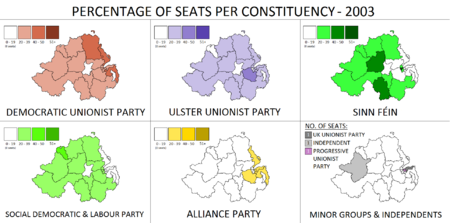- Northern Ireland Assembly election, 2003
-
Northern Ireland Assembly election, 2003 
1998 ←
members26 November 2003 → 2007
membersAll 108 seats to the Northern Ireland Assembly
55 seats needed for a majorityFirst party Second party Third party 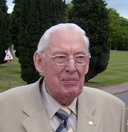
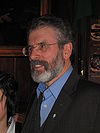
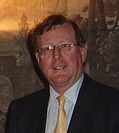
Leader Ian Paisley Gerry Adams David Trimble Party Democratic Unionist Sinn Féin Ulster Unionist Leader since 30 September 1971 13 November 1983 8 September 1995 Leader's seat North Antrim Belfast West Upper Bann Last election 20 seats, 18.5% 18 seats, 16.7% 28 seats (21.3%) Seats won 30 24 27 Seat change  10
10 6
6 1
1Popular vote 177,944 162,758 156,931 Percentage 25.7% 23.5% 22.7% Swing  7.2%
7.2% 6.8%
6.8% 1.4%
1.4%Fourth party Fifth party 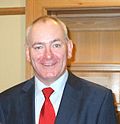
Leader Mark Durkan David Ford Party SDLP Alliance Leader since 10 November 2001 6 October 2001 Leader's seat Foyle South Antrim Last election 24 seats (22.0%) 6 seats (5.6%) Seats won 18 6 Seat change  6
6 0
0Popular vote 117,547 25,372 Percentage 17.0% 3.7% Swing  5%
5% 1.9%
1.9%
Percentage of seats gained by each of the party.
First Minister before election
Suspended
Elected First Minister
Suspended
Northern Ireland 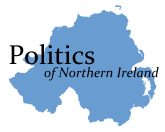
This article is part of the series:
Politics and government of
Northern IrelandNorthern Irish LawNI in the UKNI in the EU
The second elections to the Northern Ireland Assembly, which at the time of the elections had been suspended for just over a year, were held on Wednesday 26 November 2003. Six members were elected by Single Transferable Vote from each of Northern Ireland's eighteen Westminster Parliamentary constituencies, giving a total of 108 MLAs, or Members of the Legislative Assembly. The elections were contested by 18 parties, and a number of independent candidates.
The elections were originally planned for May 2003,[1] but were delayed by the Secretary of State for Northern Ireland.[1]
Contents
Political Parties
On the unionist side, the Democratic Unionist Party gained ten seats, primarily at the expense of smaller Unionist parties, to become the largest party both in seats and votes. Despite slipping to third place in first preference votes the Ulster Unionist Party actually increased their vote slightly and had a net loss of only one seat. Shortly after the election three Ulster Unionist MLAs, Jeffrey Donaldson, Nora Beare and Arlene Foster, defected to the Democratic Unionists.
On the nationalist side, Sinn Féin saw a big increase in their vote, gaining six seats at the net expense of the Social Democratic and Labour Party.
The minor parties all saw a significant fall in their support. The Alliance Party managed to hold all six of its seats despite their vote almost halving, the Women's Coalition, United Unionist Coalition and Northern Ireland Unionist Party were all wiped out, and the Progressive Unionist Party and UK Unionist Party had just one seat each.
The biggest surprise of the election came in West Tyrone with the election of the independent Dr. Kieran Deeny, campaigning on the single issue of hospital provision in Omagh.
Note
Several sitting MLAs stood under a different label to the one they had used in 1998. Some had failed to be selected by their parties to stand and so stood as independents, whilst others had changed parties during the course of the assembly. Most of these realignments occurred within the unionist parties, with several defections between existing parties and two new parties being formed - the United Unionist Coalition (formed by the three MLAs elected as independent unionists, though one later joined the Democratic Unionist Party) and the Northern Ireland Unionist Party (formed by four of the five MLAs elected as the UK Unionist Party, though one later left them, joined the Democratic Unionists for a period but contested the election as an independent unionist). Neither the United Unionist Assembly Party nor the Northern Ireland Unionists won any seats in the 2003 election.
Results
Party Leader Seats +/- % of seats Number % of vote Democratic Unionist Ian Paisley 30 +10 27.8 177,944 25.7 Sinn Féin Gerry Adams 24 +6 22.2 162,758 23.5 Ulster Unionist David Trimble 27 -1 25 156,931 22.7 SDLP Mark Durkan 18 -6 16.7 117,547 17.0 Alliance David Ford 6 0 5.6 25,372 3.7 Independent N/A 1 +1 0.9 20,234 2.9 Progressive Unionist David Ervine 1 -1 0.9 8,032 1.2 NI Women's Coalition Monica McWilliams 0 -2 5,785 0.8 UK Unionist Robert McCartney 1 -4 0.9 5,700 0.8 United Unionist Council Denis Watson 0 N/A 2,705 0.4 Green (NI) John Barry 0 0 2,688 0.4 Socialist Environmental Goretti Horgan 0 N/A 2,394 0.4 Workers' Party Seán Garland 0 0 1,881 0.3 Conservative Michael Howard 0 0 1,604 0.2 NI Unionist Cedric Wilson 0 N/A 1,350 0.2 Socialist Party Peter Hadden 0 N/A 343 0.0 Rainbow Dream Ticket Rainbow George 0 N/A 124 0.0 Ulster Third Way David Kerr 0 N/A 16 0.0 Total 108 0 100.0 692,028 100.0 - All parties with over 1,000 votes shown.
Electorate: 1,097,526; Valid votes: 692,028; Turnout: 63.05%.
- SOURCE: ARK website
Votes summary
Seats summary
See also
Elections and referendums in Northern Ireland Elections Local government elections 1973 · 1977 · 1981 · 1985 · 1989 · 1993 · 1997 · 2001 · 2005 · 2011Referendums References
Categories:- Elections in Northern Ireland
- 2003 elections in the United Kingdom
- 2003 in Northern Ireland
- Northern Ireland Assembly
Wikimedia Foundation. 2010.

